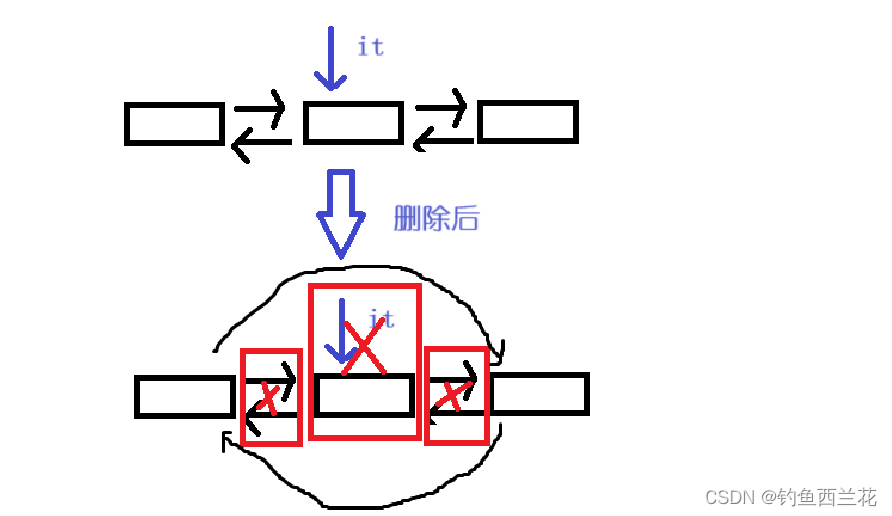做网站北京精准营销策略都有哪些
目录
一、模拟实现list
1、list的基本结构
2、迭代器封装
2.1 正向迭代器
2.2 反向迭代器
3、指定位置插入
4、指定位置删除
5、结语
前言:
list是STL(标准模板库)中的八大容器之一,而STL属于C++标准库的一部分,因此在C++中可以直接使用list容器存储数据。list实质上是一个带头双向循环链表,这也使得他能够在常数的时间复杂度范围内插入和删除数据,缺点是不能像数组那样进行元素下标的随机访问。

一、模拟实现list
在C++中可以直接调用库里的list,并且使用起来非常的简便,和使用vector、string相差无几,但是为了能够更好的了解list和其底层原理,下文会对lsit的常用接口进行模拟实现,以便对list有更深入的理解,并且list的底层实现逻辑完美的表现了面向对象的思想。
1、list的基本结构
与实现vector和string不一样,list可以分成两个整体:链表本身、节点本身,因此需要两个类(链表类、节点类)完成list的基本实现,并且把节点类看作是一个普通的节点,而实现链表的具体功能函数都放在链表类中。
list基本功能代码如下:
#define _CRT_SECURE_NO_WARNINGS 1#include<iostream>
using namespace std;namespace ZH
{template <class T>struct list_node//节点类{list_node<T>* prev;list_node<T>* next;T val;list_node(const T& t):prev(nullptr), next(nullptr), val(t){}};template <class T>class list//链表类{public:typedef list_node<T> node;//让节点类看起来像一个普通的节点list()//构造函数、目的是创建哨兵位头节点:_node(new node(-1)){_node->next = _node;_node->prev = _node;}void push_front(const T& t)//头插{node* newnode = new node(t);node* cur = _node->next;_node->next = newnode;newnode->prev = _node;newnode->next = cur;cur->prev = newnode;}void Print()//打印数据{node* cur = _node->next;while (cur != _node){cout << cur->val << " ";cur = cur->next;}}~list()//析构{node* cur = _node->next;node* dest = cur->next;while (cur != _node){delete cur;cur = dest;dest = dest->next;}delete _node;_node = nullptr;}private:node* _node;};
}int main()
{ZH::list<int> lt;lt.push_front(1);lt.push_front(2);lt.push_front(3);lt.push_front(4);lt.Print();return 0;
}运行结果:

从上面的代码可以发现, list的底层实现和之前c语言中实现双向循环链表的逻辑一模一样,只不过用C++的方式将其进行了封装。
这里节点类里的成员变量要放在公有域(struct定义类默认为公有域),因为在list中会改变节点前后指针的指向,因此节点的指针要设为外部可见。
2、迭代器封装
2.1 正向迭代器
在调用库里面的list,会发现库里面list的迭代器用起来像是一个指针,因为可以对迭代器进行解引用操作以及++操作。所以在模拟实现迭代器时,我们也用一个指针来模拟迭代器的行为,不同的是指针进行++操作时,会指向该地址的下一个地址,而我们期望的迭代器++可以指向下一个节点。
示意图如下:

因此,如果单单的把指针看成迭代器则无法实现遍历链表的功能,所以要实现迭代器必须对指针进行又一层的封装,也就是把迭代器写成一个类,但是该类的底层还是一个节点指针,只是对该指针的操作有了新的规定。
正向迭代器代码实现如下:
#define _CRT_SECURE_NO_WARNINGS 1#include<iostream>
using namespace std;namespace ZH
{template <class T>struct list_node//节点类{list_node<T>* prev;list_node<T>* next;T val;list_node(const T& t):prev(nullptr), next(nullptr), val(t){}};template<class T>struct list_iterator//迭代器类{typedef list_node<T> node;typedef list_iterator<T> self;node* _node;// 成员变量list_iterator(node* node):_node(node){}bool operator!=(const self& s)//重载!={return _node != s._node;}self& operator++()//重载前置++{_node = _node->next;return *this;}T& operator*()//重载解引用{return _node->val;}};template <class T>class list//链表类{public:typedef list_node<T> node;//让节点类看起来像一个普通的节点typedef list_iterator<T> iterator;//让迭代器类看起来像一个迭代器list()//构造函数、目的是创建哨兵位头节点:_node(new node(-1)){_node->next = _node;_node->prev = _node;}void push_front(const T& t)//头插{node* newnode = new node(t);node* cur = _node->next;_node->next = newnode;newnode->prev = _node;newnode->next = cur;cur->prev = newnode;}iterator begin(){//begin返回的是一个指向头节点的下一个节点的迭代器对象return iterator(_node->next);//匿名对象创建并返回}iterator end(){//begin返回的是一个指向头节点的迭代器对象return iterator(_node);//匿名对象创建并返回}~list()//析构{node* cur = _node->next;node* dest = cur->next;while (cur != _node){delete cur;cur = dest;dest = dest->next;}delete _node;_node = nullptr;}private:node* _node;//指向哨兵位的头节点};
}int main()
{ZH::list<int> lt;lt.push_front(1);lt.push_front(2);lt.push_front(3);lt.push_front(4);ZH::list<int>::iterator it = lt.begin();while (it!=lt.end()){cout << *it << " ";++it;}return 0;
}运行结果:

注意,这里的it要看成是一个对象,他的类型是 list<int>::iterator。ZH::list<int>::iterator it = lt.begin();这句代码实际上是调用了拷贝构造,用begin()的返回对象构造了一个新的对象it。
2.2 反向迭代器
反向迭代器与正向迭代器的区别在于,反向迭代器是从链表的最后一个节点开始往前遍历的,并且他的逻辑和正向迭代器的逻辑是相反的,可以确定的一点是反向迭代器也是通过一个类来实现的。
反向迭代器实现代码如下:
#define _CRT_SECURE_NO_WARNINGS 1#include<iostream>
using namespace std;namespace ZH
{template <class T>struct list_node//节点类{list_node<T>* prev;list_node<T>* next;T val;list_node(const T& t):prev(nullptr), next(nullptr), val(t){}};template<class T>struct list_iterator//迭代器类{typedef list_node<T> node;typedef list_iterator<T> self;node* _node;// 成员变量list_iterator(node* node):_node(node){}bool operator!=(const self& s)//重载!={return _node != s._node;}self& operator++()//重载前置++{_node = _node->next;return *this;}self& operator--()//重载前置--{_node = _node->prev;return *this;}T& operator*()//重载解引用{return _node->val;}};template<class T>class list_reverse_iterator{public:typedef list_iterator<T> iterator;typedef list_reverse_iterator<T> rself;list_reverse_iterator(iterator it):rit(it){}bool operator!=(const rself& s)//重载!={return rit!= s.rit;//复用正向迭代器的!=重载}rself& operator++()//重载前置++{--rit;//复用正向迭代器的++return *this;}T& operator*()//重载解引用{return *rit;//复用正向迭代器的解引用}private:iterator rit;};template <class T>class list//链表类{public:typedef list_node<T> node;//让节点类看起来像一个普通的节点typedef list_iterator<T> iterator;//让迭代器类看起来像一个迭代器typedef list_reverse_iterator<T> reverse_iterator;list()//构造函数、目的是创建哨兵位头节点:_node(new node(-1)){_node->next = _node;_node->prev = _node;}void push_front(const T& t)//头插{node* newnode = new node(t);node* cur = _node->next;_node->next = newnode;newnode->prev = _node;newnode->next = cur;cur->prev = newnode;}reverse_iterator rbegin(){return reverse_iterator(iterator(_node->prev));//返回最后一个节点}reverse_iterator rend(){return reverse_iterator(iterator(_node));//返回头节点}~list()//析构{node* cur = _node->next;node* dest = cur->next;while (cur != _node){delete cur;cur = dest;dest = dest->next;}delete _node;_node = nullptr;}private:node* _node;//指向哨兵位的头节点};
}int main()
{ZH::list<int> lt;lt.push_front(1);lt.push_front(2);lt.push_front(3);lt.push_front(4);ZH::list<int>::reverse_iterator rit = lt.rbegin();while (rit != lt.rend()){cout << *rit << " ";++rit;}return 0;
}运行结果:

从上述代码中可以发现,反向迭代器是复用正向迭代器的成员函数达到实现的,只不过在反向迭代器类里进行又一层包装。
3、指定位置插入
有了迭代器,就可以实现从指定位置插入了,指定位置插入代码如下:
void Insert(iterator pos, const T& val)//插入{node* newnode = new node(val);node* cur = pos._node;node* prev = cur->prev;prev->next = newnode;newnode->prev = prev;newnode->next = cur;cur->prev = newnode;}值得注意的是,list的插入不会导致迭代器失效,因为即使在该迭代器指向节点的前面插入一个数据,则该迭代器还是指向该节点的。

4、指定位置删除
指定位置删除代码如下:
void Erase(iterator pos)//删除{assert(pos != end());node* cur = pos._node;node* prev = cur->prev;node* next = cur->next;prev->next = next;next->prev = prev;delete cur;}删除逻辑示意图:

删除与插入不同在于,删除之后迭代器会失效,因为此时it指向的是一块被回收的区域,不能直接访问it所指向的区域,会导致野指针问题。
5、结语
以上就是关于list如何实现的讲解,list的模拟实现完全体现了面向对象的思想,链表本身、节点以及迭代器都被封装成一个类,从用户的角度看,是在对象的层面上直接进行操作的,但是底层却是各种复用,依旧是通过操作内置类型来实现上层的对象之间的操作。
最后希望本文可以给你带来更多的收获,如果本文对你起到了帮助,希望可以动动小指头帮忙点赞👍+关注😎+收藏👌!如果有遗漏或者有误的地方欢迎大家在评论区补充,谢谢大家!!
